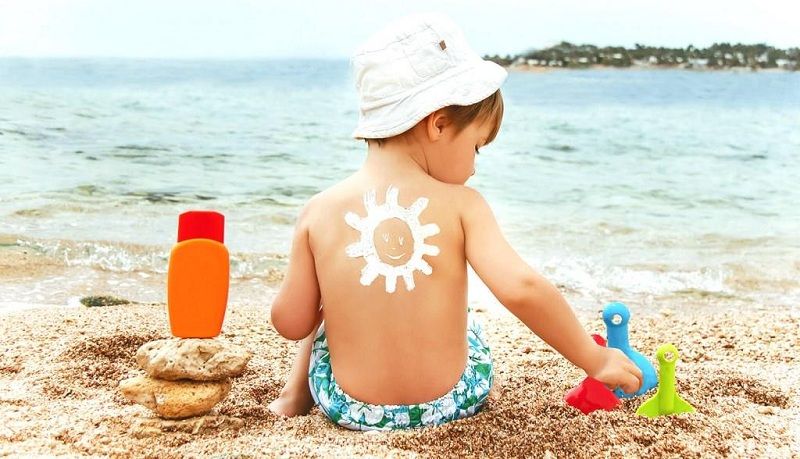
Allergy To The Sun In A Child: Symptoms And Treatment
No sooner had the little child returned from a walk on a fine summer day, when his skin became covered with a small red rash and began to itch. It looks like the baby has all the symptoms of photodermatosis on the face. That is how the medical terminology is called sun allergy. Anomalous reaction to ultraviolet light occurs most frequently in children under three years of age. In older children, it is much less common. Where do unpleasant symptoms come from and what to do to get rid of allergy to the sun?

Causes of Allergies
Most mommies consider intense solar radiation to be the culprit for unpleasant skin reactions, but doctors have denied this misconception. In fact, photodermatosis refers to pseudo-allergies, because ultraviolet in its pure form is not an allergen. Why, then, the rash occurs?
Allergic symptoms appear when ultraviolet rays interact with a specific reagent that is in the child’s body. These substances are called photosensitizers. The sun is only a kind of catalyst. Influencing the foreign substances accumulated in the skin, it triggers a chain of unusual immune responses.
Why are “solar” allergies most susceptible to young children? The reason is that in a thin, sensitive skin of a child, a protective mechanism has not yet been fully formed that resists the action of ultraviolet radiation. Babies produce a smaller amount of melanin compared to adults. This skin pigment absorbs UV rays, thereby neutralizing their harmful effects. Light-skinned children are naturally a particular risk group.

Typical symptoms
Signs of allergy to the sun are similar to the manifestations of other dermatoses. The mechanism of development of photodermatosis is not completely clear, but its diagnosis does not cause difficulties. Skin reactions begin to disturb the baby sometime after being outside in sunny weather and only in areas of the body that are not covered by clothes. Photodermatosis can be suspected if the child has:
- skin redness;
- itching, tingling, or burning;
- small reddish rash;
- swelling of the skin;
- peeling;
In especially sensitive babies, even small blisters can appear. After a couple of weeks, and with proper treatment even faster, the symptoms disappear, but after another stay in the sun can appear again.
If you suspect a child has a “sun” allergy, pay attention to the places where skin rashes are located. With photodermatitis, the face most often suffers the forehead, cheeks, ears, less often the body, hands or feet. At the same time, the places closed from the sun, for example behind the ears, under the chin, remain clean.

Exacerbations of solar allergies occur with the onset of the spring-summer season. Most often relapses occur in March and June. Especially carefully you need to monitor the condition of the skin of the baby on vacation in countries with hot climates. In the tropical climate zone, the probability of allergy to the sun increases.
Where do the provocateurs “live”?
The most typical symptoms of the so-called “meadow” photodermatosis. Its source is furocoumarins contained in flowering plants. Microscopic pollen accumulates on the skin and under the action of solar radiation becomes an allergen. That is why a walk in the hot summer in the green zone can provoke an allergy to the sun.
In addition, allergic reactions can occur if in the summer to smear baby skin with some creams, antiseptic lotions and other external agents. The substances entering into their structure, being activated on the sun, are also capable to cause unpleasant symptoms. Essential oils, such as roses, citrus fruits, bergamot, as well as extracts of dill, parsley, and other herbs have been proven to have a similar effect. Therefore, purchasing a particular child remedy is sure to check the composition on the label. It is better if the perfume in it will be absent.
No matter how incredible it may sound, even sunscreen sometimes causes allergies to the sun. Manufacturers often add to tanning products compounds known as PABK. When activated with ultraviolet light on delicate baby skin, they can become a source of allergies.

Care should be taken to hygienic lipstick, in which there is eosin – dye with a strong phototoxic effect. Children who have symptoms of “solar” allergy, it is undesirable to lubricate their hands with antiseptic lotions. In the sun, they can also cause skin irritation. The audit should be subjected to the usual means of hygiene: soap, shampoos, baby creams and replace them with hypoallergenic analogs.
Another possible provocateur hides in certain drugs, in particular, antibiotics. If a child has received treatment with any drugs before the onset of allergy symptoms to the sun, be sure to inform your doctor.
Even water with bleach can act as a photosensitizer. Therefore, if a child prone to allergies, visits the pool, it is necessary to take a shower before going out into the bright sun.
Photodermatosis in the eyes
Individual children are allergic to the sun to a greater extent affects a particularly sensitive eye region. In this situation, under the action of ultraviolet inflammation of the mucous membrane of the eye.

Symptoms of such a “solar” allergy:
- redness of the eyes;
- peeling, irritation, swelling of the eyelids;
- burning and itching;
- painful photosensitivity;
- discharge from the eyes;
- tearing;
Diagnose Allergy to the Sun
To confirm the truth of the diagnosis, doctors use the method of photo tests. To do this, several areas of the skin are exposed to ultraviolet radiation. The intensity of UVA and UVB rays increases exponentially to determine the minimum reactive dose. Photoset results are evaluated immediately and after 24 hours.
Treatment
At the first symptoms of allergy, try to minimize the presence of a child in direct sunlight. Since the signs of photodermatosis are easily confused with other allergic diseases, do not hesitate to consult a pediatric allergist or a dermatologist. Try to visit the doctor, even if the child is on vacation.
As a pre-medical aid, we can recommend folk remedies that relieve skin itching and relieve redness. To the irritated places, you can attach sheets of fresh cabbage, thin circles of cucumber or spread with aloe juice.

In the treatment of allergies from the sun are used both external and internal preparations. To relieve painful itching, an allergist may recommend antihistamine medicines; to eliminate skin manifestations – local hormone creams. To relieve the toxic load on the body, children are shown the latest generation of antihistamines, which have an optimal safety profile. In no case should the child be smeared with antipruritic ointment from a home first-aid kit designed for adults.
The sun allergy treatment regimen may include medications that improve epidermis regeneration. Antioxidants, vitamins B, E, and C do a good job with this task. The course of treatment usually lasts from several days to 2-3 weeks in severe or neglected cases.
It is forbidden to stay in the open sun for the entire duration of the therapy. Choose to walk shaded areas. It is necessary to dress the child in light clothes from natural fabrics (cotton, flax). It should completely cover the body of the child from sun exposure. As a headdress, use a wide-brimmed hat.

Treatment of photodermatosis of the eye has some peculiarities. To relieve inflammation, the ophthalmologist will recommend special drops. Before visiting the doctor, the eyes can be washed with chamomile decoction or weak tea. To avoid similar symptoms in the future, it is advisable for such a child to wear sunglasses.
With repeated episodes of photodermatosis, eczema may occur. It is much more difficult to treat such lesions. Therefore, to exclude relapses and completely get rid of an allergy to the sun, the child must comply with certain preventive measures. Many parents have the opinion that children “outgrow” this type of allergy. This is true, but not for every kid. In some children without treatment, the symptoms can worsen and become a serious problem.
Prevention
In most cases, to prevent photodermatosis, it is enough to protect the child from prolonged exposure to the sun. Since it is impossible to completely avoid exposure to sunlight, allergic kids are advised to use sunscreen creams for children.

Organic sun creams containing natural pigments, for example, zinc oxide, are the safest for the child. Do not forget that sunscreens that contain chemical UV filters and parabens themselves can trigger allergies. Usually, safe creams have the prefix “Baby” in the title.
Phototherapy with UV rays is used as a prophylactic treatment. It takes place 1-2 months before the beginning of the spring season. Phototherapy procedures should be done several times a week. Course duration – 5 weeks. Thus, the skin becomes tolerant to the action of ultraviolet radiation.
Carefully!
Earlier it was said that some drugs increase the sensitivity of children’s skin to the sun. Therefore, if a child has recently had a disease, and potent drugs (antibiotics, cytostatics, NSAIDs) have been used in treatment, do not rush to heal the baby with sunbathing. Of course, my mother wants the child to run in the sun, but you should not hurry with it.
In the bright sun, a child’s body spends its resources on intensive melanin synthesis, and not on a quick recovery. As a result, immunity suppressed by a disease may fail. Doctors recommend that the recovering baby is strengthened not with sunbathing, but with a vitamin diet with a high content of fruits and vegetables. Moreover, vitamin deficiency itself provokes the child’s vulnerability to sunlight.

Summary
The main thing to remember is that the treatment of childhood allergies to the sun should be started as soon as possible. Do not expect that next year the child will “outgrow” the disease itself. Entrust his treatment to an experienced pediatric allergist, and you will forget about photodermatosis forever.


